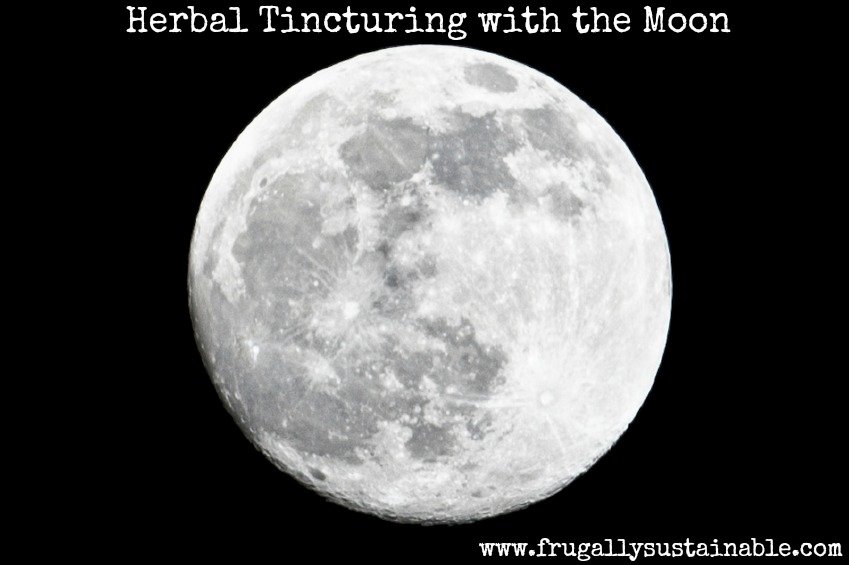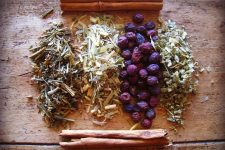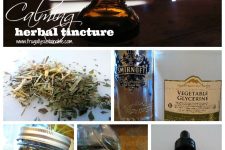
A tincture is an herbal preparation made with a liquid — often referred to as a solvent or menstruum — and herbs.
In the simplest of terms a tincture is a concentrated liquid extract.
Tincturing herbs is a very safe and effective way to preserve fresh, homegrown herbs…one that our ancestors knew very well.
The sense of satisfaction you will receive after preparing herbs using this traditional method is extremely empowering and rewarding!
Lunar-Based Tincturing
There are certain times in the month that can effect the potency of herbal tinctures…this depending on the lunar cycle of the moon.
Folklore tells us to start preparing tinctures when the moon is dark — or otherwise known as the day of the new moon.
The new moon is the beginning of the lunar cycle and every 14-15 days the moon cycles from new to full moon — with the waning and waxing moons in between.
You may hear many older herbalist and grandparents who speak about gardening (planting and harvesting) and medicine making with the cycles of the moon.
They used the moon as a guide.
They knew the best time for preparing a tincture was on the new moon. Not only because it is a sign of new beginnings, but it is the time when the gravitational pull of the moon helps to draw out the natural healing properties in the plants — making one of the most the most powerful and predominant medicinal tinctures possible.
I love making medicine and preserving herbs in this way…
…but most of all, I love that in doing so I remain connected to all of the amazing women before me who learned the necessary homemaking tasks of cooking from scratch, gardening, mending, preserving the harvest, herbal crafting, and soap-making.
Tincturing Basics

Tinctures can be created using a variety of different solvents (or menstruums), such as:
Alcohol
- Most commonly used solvent.
- Extracts many healing properties from the plant material.
- Vodka (100 proof is best, 80 proof will do), brandy or rum are the types of alcohol used frequently.
- Tinctures created with alcohol are the most resistant to contaminates and have the longest shelf life – retaining potency for 5 years or more.
Vinegar
- Tinctures made with vinegar must be used within 1 year of straining.
- Always use raw, organic apple cider vinegar and warm it slightly before adding to herbs for best results (This is the brand I use and trust the most!).
- The vinegar should contain at least 5% acidity.
- Do not dilute, use full-strength.
- Vinegar tinctures are not as potent as alcohol tinctures.
- Use nothing but food-grade vegetable glycerin for tincturing (I always get Organic Vegetable Glycerin here from Mountain Rose Herbs).
- Not as strong as an alcohol tincture.
- Great for those do not want to consume alcohol.
- Is very sweet…great for children’s taste buds.
- Must be diluted at a 60% vegetable glycerin 40% water ratio prior to adding to herbs.
- Should keep for 2-3 years after straining in a cool, dark place.
Tincturing – A General Recipe
Ingredients
-4 ounces fresh herbs, chopped (or 2 ounces of dried herbs)
-quart-sized glass jar
-100 proof vodka to fill (approximately 16 ounces)
Method
1. Measure the herbs you will use in your recipe using a small kitchen scale.
2. Chop the fresh herbs until fine using a blender, food processor, or by hand.
3. On the new moon place plant material into the quart-sized glass jar.
4. Pour your solvent, in this case vodka, over the herbs until it reaches approximately 2 inches above the herbs.
5. Stir well to combine. Then place a lid on the jar and shake.
6. The jar should rest in a warm place, steeping near a sunny window, and it should be shook at least once daily (twice is best).
7. Strain on the full moon if needed, or leave for steeping for up to 6 weeks.
8. Pass tincture through a cheesecloth lined fine mesh sieve. Reserve liquid and compost plant material.
9. Keep the strained tincture in a dark colored glass bottle or clear glass in a cool, dark place.
10. Label each bottle with the name, date, and contents.
Resources
Here are some recipes from the archives:
Learn more about basic Herbal Preparations with these great reads:




 Bug Salve: How to Make a DEET-Free Bug Repellent Balm
Bug Salve: How to Make a DEET-Free Bug Repellent Balm
I find that really fascinating but I’m not that surprised. About a year ago I started keeping a record of when each New Moon happens every month. Now I am much more aware of how the new moon and the days around the New Moon affect me emotionally.
There is even a book about how making affirmations during the period right after a New Moon makes this affirmations particularly potent (New Moon Astrology by Jan Spiller)
Hello,
I’ve been reading your posts for a while now but somehow missed reading this one, probably because I’ve been making herbal preparations and tinctures for years and know how, but I just stumbled across it tonight and wanted to say thank you for posting about working with moon cycles. Most people think I’m nuts (or, a “lunatic”) when I say I garden by the moon cycles. I’ve never had better germination rates than any other technique, not to mention adding a touch of magic you just can’t get any other way. Thanks!